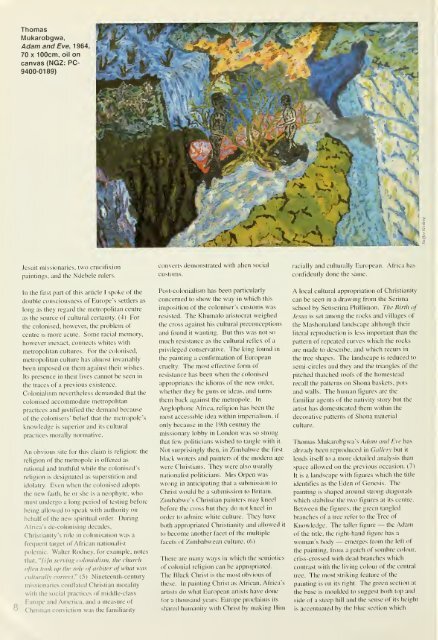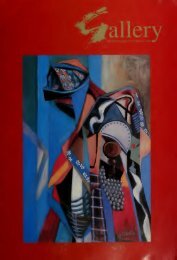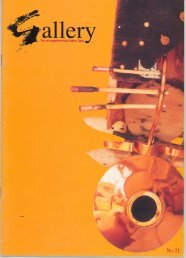Gallery : the art magazine from Gallery Delta
Gallery : the art magazine from Gallery Delta
Gallery : the art magazine from Gallery Delta
Create successful ePaper yourself
Turn your PDF publications into a flip-book with our unique Google optimized e-Paper software.
Thomas<br />
Mukarobgwa,<br />
Adam and Eve, 1 964,<br />
70 X 100cm, oil on<br />
canvas (NGZ: PC-<br />
9400-0189)<br />
Jesuit missionaries, two crucifixion<br />
paintings, and <strong>the</strong> Ndebele rulers.<br />
In <strong>the</strong> tlnst p<strong>art</strong> of this <strong>art</strong>icle I spoke of <strong>the</strong><br />
double consciousness of Europe's settlers as<br />
long as <strong>the</strong>y regard <strong>the</strong> metropolitan centre<br />
as <strong>the</strong> source of cultural certainty. (4) For<br />
<strong>the</strong> colonised, however, <strong>the</strong> problem of<br />
centre is more acute. Some racial memory,<br />
however inexact, connects whites with<br />
metropolitan cultures. For <strong>the</strong> colonised,<br />
metropolitan culture has almost invariably<br />
been imposed on <strong>the</strong>m against <strong>the</strong>ir wishes.<br />
Its presence in <strong>the</strong>ir lives cannot be seen in<br />
<strong>the</strong> traces of a previous existence.<br />
Colonialism never<strong>the</strong>less demanded that <strong>the</strong><br />
colonised accommodate metropolitan<br />
practices and justified <strong>the</strong> demand because<br />
of <strong>the</strong> colonisers' belief that <strong>the</strong> metropole's<br />
knowledge is superior and its cultural<br />
practices morally normative.<br />
An obvious site for this claim is religion: <strong>the</strong><br />
religion of <strong>the</strong> metropole is offered as<br />
rational and truthful while <strong>the</strong> colonised's<br />
religion is designated as superstition and<br />
idolatry. Even when <strong>the</strong> colonised adopts<br />
<strong>the</strong> new faith, he or she is a neophyte, who<br />
must undergo a long period of testing before<br />
being allowed to speak with authority on<br />
behalf of <strong>the</strong> new spiritual order. During<br />
Africa's de-colonising decades,<br />
Christianity's role in coloiusation was a<br />
frequent target of African nationalist<br />
polemic. Walter Rodney, for example, notes<br />
thai, '7'/" scrviiifi rolonialixm. <strong>the</strong> church<br />
often took up <strong>the</strong> role ofcirhiter of what wci.t<br />
culturally correct." (5) Nineteenth-century<br />
missionaries conflated Christian morality<br />
with <strong>the</strong> social practices of middle-class<br />
Europe and America, and a measure of<br />
Christian conviction was <strong>the</strong> familiarity<br />
t -A' ji^^MlL^<br />
converts demonstrated with alien social<br />
customs.<br />
Post-colonialism has been p<strong>art</strong>icularly<br />
concerned to show <strong>the</strong> way in which this<br />
imposition of <strong>the</strong> coloniser's customs was<br />
resisted. The Khumalo aristocrat weighed<br />
<strong>the</strong> cross against his cultural preconceptions<br />
and found it wanting. But this was not so<br />
much resistance as <strong>the</strong> cultural reflex of a<br />
privileged conservative. The king found in<br />
<strong>the</strong> painting a confirmation of European<br />
caielty. The most effective form of<br />
resistance has been when <strong>the</strong> colonised<br />
appropriates <strong>the</strong> idioms of <strong>the</strong> new order,<br />
whe<strong>the</strong>r <strong>the</strong>y be guns or ideas, and turns<br />
<strong>the</strong>m back against <strong>the</strong> metropole. In<br />
Anglophone Africa, religion has been <strong>the</strong><br />
most accessible idea within imperialism, if<br />
only because in <strong>the</strong> 19th century <strong>the</strong><br />
missionary lobby in London was so strong<br />
that few politicians wished to tangle with it.<br />
Not surprisingly <strong>the</strong>n, in Zimbabwe <strong>the</strong> first<br />
black writers and painters of <strong>the</strong> modern age<br />
were Christians. They were also usually<br />
nationalist politicians. Mrs Orpen was<br />
wrong in anticipating that a submission to<br />
Christ would be a submission to Britain.<br />
Zimbabwe's Christian painters may kneel<br />
before <strong>the</strong> cross but <strong>the</strong>y do not kneel in<br />
order to admire white culture. They have<br />
both appropriated Christianity and allowed it<br />
to become ano<strong>the</strong>r facet of <strong>the</strong> multiple<br />
facets of Zimbabwean culture. (6)<br />
There are many ways in which <strong>the</strong> scnuotics<br />
of colonial religion can be appropriated.<br />
The Black Christ is <strong>the</strong> most obvious of<br />
<strong>the</strong>se. In painting Christ as African. Africa's<br />
<strong>art</strong>ists do what European <strong>art</strong>ists have done<br />
for a thousand years; Europe proclaims its<br />
shared humanity with Christ by making Him<br />
racially and culturally European. Africa has<br />
confidently done <strong>the</strong> same.<br />
A local cultural appropriation of Christianity<br />
can be seen in a drawing <strong>from</strong> <strong>the</strong> Serima<br />
school by Sen.serina Phillimon. The Birth of<br />
Jesus is set among <strong>the</strong> rocks and villages of<br />
<strong>the</strong> Mashonaland landscape although <strong>the</strong>ir<br />
literal reproduction is less important than <strong>the</strong><br />
pattern of repeated curves which <strong>the</strong> rocks<br />
are made to describe, and which recurs in<br />
<strong>the</strong> tree shapes. The landscape is reduced to<br />
.semi-circles and <strong>the</strong>y and <strong>the</strong> triangles of <strong>the</strong><br />
pitched thatched roofs of <strong>the</strong> homestead<br />
recall <strong>the</strong> patterns on Shona baskets, pots<br />
and walls. The human figures are <strong>the</strong><br />
familiar agents of <strong>the</strong> nativity story but <strong>the</strong><br />
<strong>art</strong>ist has domesticated <strong>the</strong>m within <strong>the</strong><br />
decorative patterns of Shona material<br />
culture.<br />
Thomas Mukarobgwa's Adam ami Eve has<br />
already been reproduced in Gallerx but it<br />
lends itself to a more detailed analysis than<br />
space allowed on <strong>the</strong> previous occasion. (7)<br />
It is a landscape with figures which <strong>the</strong> title<br />
identifies as <strong>the</strong> Eden of Genesis. The<br />
painting is shaped around strong diagonals<br />
which stabilise <strong>the</strong> two figures at its centre.<br />
Between <strong>the</strong> figures, <strong>the</strong> green tangled<br />
branches of a tree refer to <strong>the</strong> Tree of<br />
Knowledge. The taller figure — <strong>the</strong> Adam<br />
of <strong>the</strong> title, <strong>the</strong> right-hand figure has a<br />
woman's body — emerges Irom <strong>the</strong> left ot<br />
<strong>the</strong> painting, <strong>from</strong> a patch of sombre colour,<br />
criss-crossed with dead branches which<br />
contrast with <strong>the</strong> living colour of <strong>the</strong> central<br />
tree. The most striking feature of <strong>the</strong><br />
painting is on its right. The green section at<br />
<strong>the</strong> base is moulded to suggest both top and<br />
side of a steep hill and <strong>the</strong> sense of its height<br />
is accentuated by <strong>the</strong> blue section which<br />
^i







